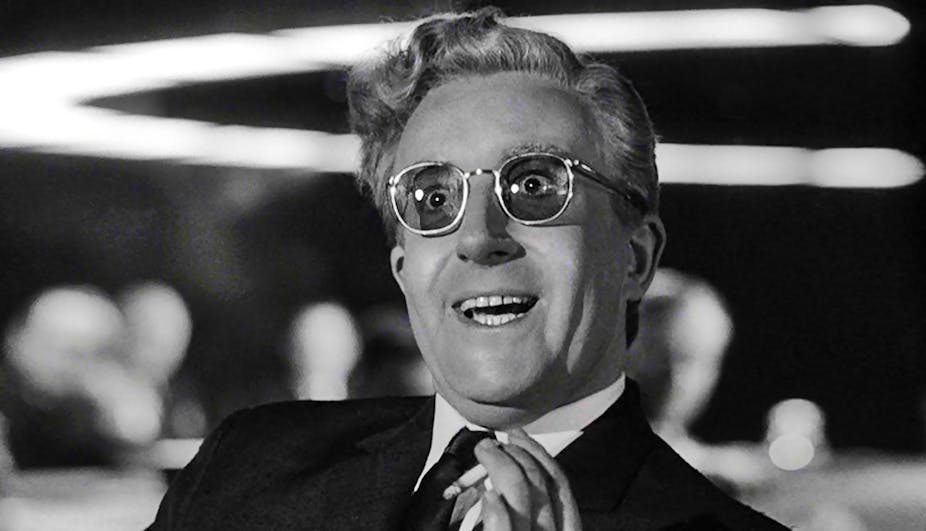Legendary director Stanley Kubrick was known to have said that he was not really a Jew, he just happened to have two Jewish parents. But though he may have tried to divert from this fact, Kubrick, who passed away in 1999 at the age of 70, was born and died a Jew, and Jewishness threads through and underpins all 13 of his films.
Kubrick was famously silent on the meaning of his movies, so their messages are open to interpretation on a number of levels. He covered many genres and topics – starting with war movie Fear and Desire in 1953, and ending with marital drama in Eyes Wide Shut (1999) – and his films broke new ground in cinematic style.
But Kubrick, who is possibly the most written about film director after Alfred Hitchcock, has rarely been thought of as a Jewish director. This is because few dedicated researchers have not bothered to probe his ethnic background in any detail.
Kubrick the Jewish man

Kubrick had a history of working with Jewish actors as his leading men and women. Notably Paul Mazursky, Joe Turkel (three times), Kirk Douglas (twice), Peter Sellers (twice), Shelley Winters, Aubrey Morris, Miriam Karlin, and Sydney Pollack. He also worked with Jewish writers, including Howard Fast, Michael Herr and Frederic Raphael, and considered adapting the work of such Jewish authors as Arthur Schnitzler, Stefan Zweig and Louis Begley. He adored the work of Sigmund Freud, the founder of psychoanalysis, and writer Franz Kafka too. But this alone is not makes him a Jewish filmmaker.
Although Kubrick was never a practising Jew and the Jewish references and viewpoint are not explicit or obvious in his films, once you consider his films from the standpoint of his ethnicity, as well as his cultural and intellectual milieu, then some resonant themes emerge.

Though Kubrick famously worked on a Holocaust film, The Aryan Papers, which never came to fruition, his body of work went far beyond that in terms of Jewish references.
His first feature, Fear and Desire (1953) is his spin on the World War II platoon movie, which typically contained a range of ethnicities and races. True to form, Kubrick cast Mazursky as the shaky (Jewish) recruit Private Sidney. Killer’s Kiss in 1955 is very much moulded in the tradition of the Jewish boxing movie – features such as Body and Soul (1947), directed by Robert Rossen. Kubrick’s film noir, The Killing (1956), could well have as its tagline the Yiddish proverb, “Man plans, God laughs”. All three of these early films could also be described as existentialist, a philosophy popular with Jewish intellectuals in the postwar era, especially in Greenwich Village, New York City, where Kubrick then lived.
In dealing with a major incident of French military injustice during World War I, Paths of Glory (1957), recalls the antisemitic Dreyfus affair, a major cause célèbre of the 19th century. The epic Spartacus (1960) posits a Moses-like liberator who leads Roman slaves out of bondage while also considering such issues as McCarthyism, the Hollywood blacklist, civil rights, the Holocaust and the birth of the State of Israel – all issues of Jewish concern in the 1950s.

In 1964, Dr. Strangelove conflated nuclear holocaust with the Holocaust, particularly through its titular character, the former Nazi Dr. Strangelove, at a time when the Adolf Eichmann Trial was fresh in people’s memories.
Looking further at Kubrick’s later films, 2001: A Space Odyssey – which celebrates its 50th anniversary this year – plays with the Hebrew Bible, Jewish liturgy, as well as Kabbalah, Jewish mysticism. It is full of numerological references with the number four recurring frequently. A Clockwork Orange (1971) explores Judeo-Christian ideas of choice and conveys a very traditional Jewish viewpoint on the issue of free will. And Barry Lyndon (1975) warns of the dangers of social climbing in places where you don’t belong – a traditional Jewish fear, particularly in the 19th and 20th centuries.
The Shining (1980) – Kubrick’s contribution to the horror genre – deals with the very biblical theme of the sacrifice of the son by the father, as found in Genesis 22. And Full Metal Jacket (1987), while ostensibly about Vietnam, is, on one level, about the Holocaust and man’s propensity to evil and genocide.
This is all capped off by Eyes Wide Shut, possibly Kubrick’s most Jewish film – given it was adapted from the work of Jewish author Arthur Schnitzler and heavily influenced by the theories of his Jewish contemporary Sigmund Freud. It also contains the most explicitly Jewish character in any Kubrick film, Victor Ziegler (played by Sydney Pollack).
Kubrick’s films never offer up anything easy or obvious. He made few statements about them. But he spent a long time working on his movies. He was meticulous and paid great attention to detail. He was extremely cultured, well read, and cultivated. He certainly had views that he wanted to share but did so in the least obvious ways. He wanted to make viewers work to understand his deeper messages.
Kubrick’s films were not just about Jews, Jewishness and Judaism, they are far wider than any single theme. But even though the man himself tried to distract from his Jewish roots, it cannot be denied that some of this material was surely intentional.

